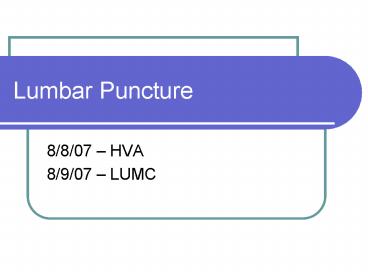Lumbar Puncture PowerPoint PPT Presentation
1 / 11
Title: Lumbar Puncture
1
Lumbar Puncture
- 8/8/07 HVA
- 8/9/07 LUMC
2
This Is A Spinal Tap
3
The Lumbar Puncture
- History
- Heinrich Irenaus Quincke
- Quinckes most notable contribution, however,
was his introduction of the lumbar puncture as a
diagnostic and therapeutic technique. He arrived
at this in an interesting and local fashion.
Following his earlier work on the physiology of
the cerebrospinal fluid he reasoned that infants
with hydrocephalus might be benefited by the
removal of some of the spinal fluid and thus
break the over-production and/or under-absorption
of liquor caused by compression of the pachonian
granulations. As Friedrich Theodor von Frerichs'
(1819-1885) assistant, he had studied in 1872 the
anatomy and physiology related to the
cerebrospinal fluid in dogs by injecting red
sulphide of mercury into the spinal subarachnoid
space. The knowledge gained thereby encouraged
him to insert a fine needle with a stylet into
the lumbar interspace of an infant, a procedure
which he thought might cause slight injury to a
root fibre of the cauda but would not cause
paralysis.From the first he recognized its
diagnostic potential (1891) and took accurate
pressure measurements at the beginning and the
end of the procedure. He also measured protein
and sugar values and described the low sugar
occurring in the CSF in purulent meningitis. He
diagnosed tuberculous meningitis by demonstrating
tubercle bacilli in the CSF and was the first
person to puncture the lateral ventricle to
obtain CSF in infants with hydrocephalus. When he
first reported the technique at the Wiesbaden
Congress in 1891 it excited little comment.
However, over the years he had the satisfaction
of seeing it become the premier diagnostic
approach in neurological disorders. - www.whonamedit.com
- James Leonard Corning
- Walter Essex Winter
4
Indications
- Diagnostic
- Infectious
- Meningitis
- Encephalitis
- Inflammatory
- Multiple Sclerosis
- Gullain-Barre syndrome
- Oncologic
- Metabolic
- Therapeutic
- Analgesia
- Anesthesia
- Antibiotics
- Antineoplastics
5
Contraindications
- Increased intracranial pressure
- Cerebral herniation
- Impending herniation
- Possible increased ICP and focal neuro signs
- Coagulopathy
- Prior lumbar surgery
- Severe vertebral osteoarthritis or degenerative
disc disease - Significant cardiorespiratory compromise
6
Technique Tips
- Raise the bed
- Prepare your tray (i.e. the tubes)
- Use your landmarks
- Sytlet in with insertion, in with removal
- Unless you hand them to a runner yourself, carry
the specimens to the lab
7
Lab Studies
- Protein
- Glucose
- Cell count with differential
- Gram stain and culture
- PCR
- Myelin basic protein
- Smear
- Lactate
- Pyruvate
8
Complications
- Herniation
- Cardiorespiratory compromise
- Pain
- Headache (36.5)
- Bleeding
- Infection
- Subarachnoid epidermal cyst
- CSF leakage
9
(No Transcript)
10
Results
- Typical Cerebrospinal Fluid Findings in Various
Types of Meningitis - Test Bacterial Viral Fungal Tubercular
- Opening pressure Elevated Usually normal
Variable Variable - White blood cell count 1,000 per mm3 lt100 per
mm3 Variable Variable - Cell differential Predominance of Predominance
of Predominance Predominance - PMNs lymphocytes of lymphocytes of
lymphocytes - Protein Mild to marked Normal to elevated
Elevated Elevated - elevation
- CSF-to-serum glucose Normal to marked Usually
normal Low Low - ratio decrease
11
the end

